-
Sasanian Seals
This web site is about Sasanian seals from an Austrian private collection. -
Shapes
Sasanian seals are stamp seals (as opposed to cylinder seals of ancient Mesopotamia). The variety of shapes is very restricted. Ellipsoids and domes are typical for seals from the Sasanian period.
1. Ellipsoid
The seal looks like an ellipsoid with a piece cut off. Thus an oval plane for the engaving is created. The back of the seal is sometimes decorated. The perforations are of different sizes.
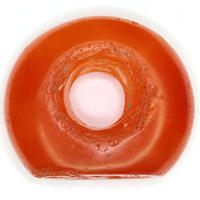 Abb. 1a
Abb. 1a
Ellipsoid
Seal Nr. 13592. Dome
The seal has the form of a sphere with a section cut off to create a rount plane for engraving. The back is occasionally decorated.
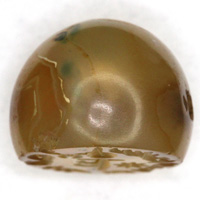 Abb. 2a
Abb. 2a
Dome
Seal Nr. 15233. Stone Ring
Some ellipsoids are very flat with a very big perforation so that they were possibly worn as rings.
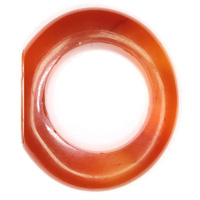 Abb. 3a
Abb. 3a
Stone Ring
Seal Nr. 08824. Ring Seal
Seal stones of the Sasanian period to be used as bezels for rings of precious metals have much the same shape as ring seals of former periods or ring seals used in contemporary Roman Empire.
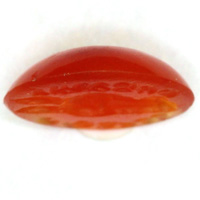 Abb. 4a
Abb. 4a
Ring Seal
Seal Nr. 0305 -
Materials
The most common material occurring in Sasanian seals is microcrystalline quartz (agate, carnelian, chalcedony, ...). There are also seals made from haematite, rock crystal, bronze, lapislazuli and some other materials.
1. Agate
Agate is a banded microcrystalline quartz. The bands can have different hues and colours. The transparency can vary from translucent to opaque. As any other microcrystalline quartz agate is porous and can be dyed. The art of dying quartzes was already known in antiquity.
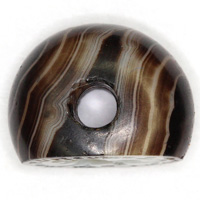 Abb. 1a
Abb. 1a
Agate
Seal Nr. 03972. Carnelian
Carnelian is a microcrystalline quartz with colours varying from red to brown. The brown version as also called sard.
 Abb. 2a
Abb. 2a
Carnelian
Seal Nr. 13593. Chalcedony
Chalcedony is a microcrystalline translucent quartz with milky white, blueish or brownish colour.
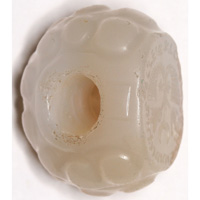 Abb. 3a
Abb. 3a
Chalcedony
Seal Nr. 04154. Jasper
Jasper is a microcrystalline opaque quartz. It can have several different colours. Some seals are made of mottled, intensely coloured jaspers.
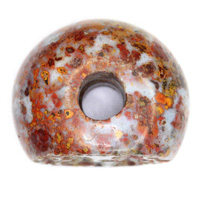 Abb. 4a
Abb. 4a
Jasper
Seal Nr. 11465. Heliotrope
Heliotrope is a dark green jasper with red specks.
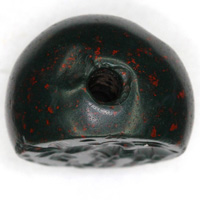 Abb. 5a
Abb. 5a
Heliotrope
Seal Nr. 15646. Rock Crystal
Rock crystal is crystalline, colourless and transparent quartz. Other than microcrystalline quartz rock crystal is not porous.
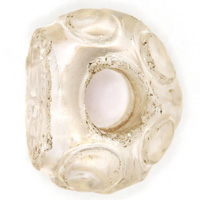 Abb. 6a
Abb. 6a
Rock Crystal
Seal Nr. 08817. Haematite
Haematite is a black and intransparent iron oxide. It is much heavier than quartz but also softer.
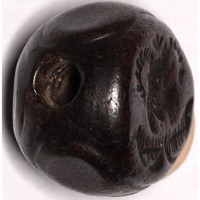 Abb. 7a
Abb. 7a
Haematite
Seal Nr. 01178. Bronze
Bronze is an alloy of copper and tin. Today seals made of bronze are covered by patina. The colour of the alloy varies from the usual golden to silvery tones. It is even heavier than haematite.
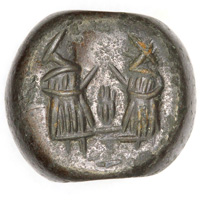 Abb. 8a
Abb. 8a
Bronze
Seal Nr. 10509. Lapislazuli
In antiquity lapislazuli was expensive and is therefore a rare material for seals. In the Sigilla collection of Sasanian seals the main occurrence is in bezels of ring seals.
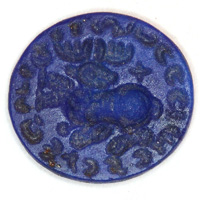 Abb. 9a
Abb. 9a
Lapislazuli
Seal Nr. 0319 -
Motifs
The motifs shown on Sasanian seals were influenced by the religious and mythological conceptions of the Sasanian era and also by ancient Oriental and Greek influences. We will give a short description of the motifs present in the Sigilla collection of Sasanian seals. With few exceptions all types of motifs ever occurring with Sasanian seals are present in the Sigilla collection of Sasanian seals.
- Inscription Only
- People
- People and Animals
- Animals
- Animals in Combination
- Mythical Creatures
- Plants & Natural Objects
- Objects & Symbols
- Monograms
1. Inscription Only
The inscription can have one, two or more lines. There can also be a surrounding inscription. The letters can be engraved as single lines or double lines.
The seals could be used for private purposes or as official seals.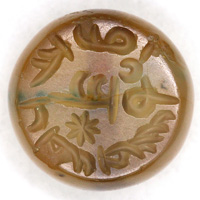 Pic. 1a
Pic. 1a
Inscription Only
Seal Nr. 15232. People
2.1 Woman
Women are dressed in a long dress and often additionally in a short coat. The face is shown in profile. The hair is dressed as a pigtail. Most of the time the woman is shown standing, sometimes also sitting. Often she has one hand raised and the other hand lowered or she is holding a plant or some other object.
The meaning a the standing or sitting woman is a much debated issue among scholars.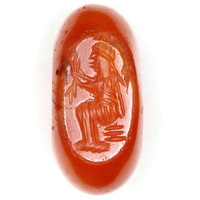 Pic. 2a
Pic. 2a
Woman
Seal Nr. 13592.2 Female Bust
The Sigilla collection of Sasanian seals has only female busts in profile. The hair is dressed in one or more pigtails falling over the shoulders. In addition they can carry earrings, a necklace or a diadem whose ties are visible behind the head.
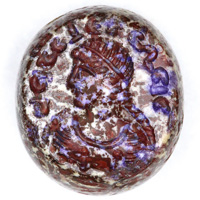 Pic. 2b
Pic. 2b
Female Bust
Seal Nr. 08892.3 Man
The man, recognizable from his hairstyle and dress is standing or walking in profile.
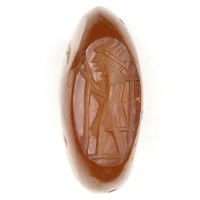 Pic. 2c
Pic. 2c
Man
Seal Nr. 12472.4 Priest
We interpret a man before a fire altar as being a priest.
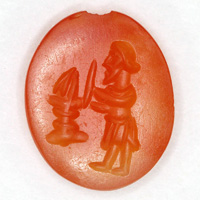 Pic. 2d
Pic. 2d
Priest
Seal Nr. 12132.5 Male Bust
The male bust is mostly shown in profile, facing busts are not so common. Most of the time the man has a beard. Headdress (Kolah) and more or less eleborated hairstyle can occur. Earrings, necklaces and elaborately decorated dressing are common.
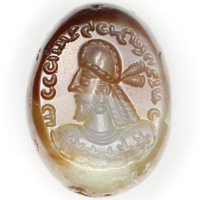 Pic. 2e
Pic. 2e
Male Bust
Seal Nr. 13412.6 Human Couple
A man and a woman are sitting or standing face to face. Together they can hold a wreath or a plant.
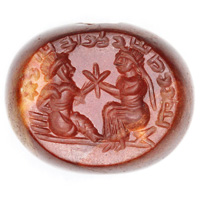 Pic. 2f
Pic. 2f
Human Couple
Seal Nr. 11452.7 Body Part
Parts of the human body are not very common on Sasanian seals. There are hands (the most common), ears (not present in the Sigilla collection of Sasanian seals), eyes (one item in the Sigilla collection of Sasanian seals).
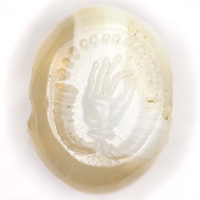 Pic. 2g
Pic. 2g
Body Part
Seal Nr. 11542.8 Gayomard
The Gayomard is a human-like creature with a naked, hairy body, a hirsute head and pointed ears. The head can be shown facing or in profile. The arms and legs are streched out. Both hands are holding a long staff. At his feet there can be a dog.
The Gayomard plays an important role in Zoroastrian mythology. It is the first human-like being created by Ahura-Mazda. It was subsequently killed by the daemon Ahriman. It will be resurrected as the first of all beings after the end of times.
It is assumed by scholars that seals with the image of the Gayomard had a role in funerary ceremonies. This assumption is supported by the fact that many seals with the image of the Gayomard are executed in such a sketchy manner so that they could not be used for sealing but rather as amulet or accessory. Also there is no known example of an extant seal impression on clay with the image of the Gayomard.
The Gayomard is sometimes identified with the constellation of the Orion, the dog with the constellation of Canis Maior.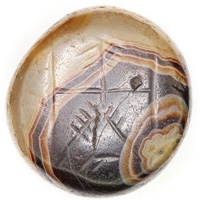 Pic. 2h
Pic. 2h
Gayomard
Seal Nr. 11862.9 Group with Gayomard
The Gayomard is standing with a human couple. The Gayomard is holding a staff. The Gayomard and the two humans are holding hands or are holding the arms upward seemingly in an expression of joy. The group is accompanied by animals: scorpion, snake, cockerel, dog. Seals of this types often have a pseudo inscription.
The Sigilla collection of Sasanian seals contains an item where the group scene with the Gayomard was re-engraved over the figure of a simple Gayomard.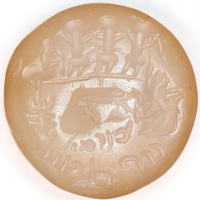 Pic. 2i
Pic. 2i
Group with Gayomard
Seal Nr. 15673. Man and Animal
3.1 Lord of Animals
A man is holding up one or two lions.
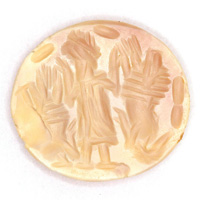 Pic. 3a
Pic. 3a
Lord of Animals
Seal Nr. 01843.2 Man Killing Animal
A man is spearing a rampant lion.
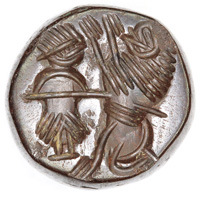 Pic. 3b
Pic. 3b
Man Killing Animal
Seal Nr. 11583.3 Horseman
The horseman is shown in profile. He can carry objects as e.g. wreath, ball, plant.
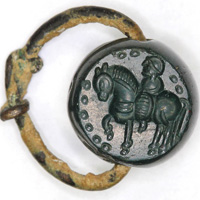 Pic. 3c
Pic. 3c
Horseman
Seal Nr. 14983.4 Hunting Horseman
The hunting horseman is attacked by a lion either from the front or from the back. Other than on the Sasanian silver plates where the mounted king is fighting the lion on the seals of the Sigilla collection of Sasanian seals no action of the horseman against the animal can be seen.
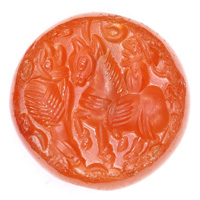 Pic. 3d
Pic. 3d
Hunting Horseman
Seal Nr. 03493.5 Priest with Ram
A man is standing before an altar and looks back to a ram behind him.
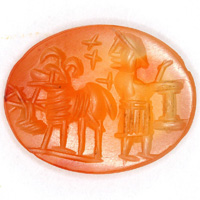 Pic. 3e
Pic. 3e
Priest with Ram
Seal Nr. 03014. Animals
4.1 Ape
The ape is shown much like a human but with a long tail. Arms and legs are streched foward.
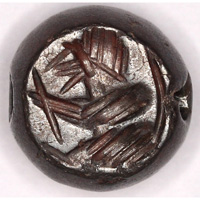 Pic. 4a
Pic. 4a
Ape
Seal Nr. 00334.2 Hare
There is no way to differentiate between hare and rabbit. The hare is shown crouching.
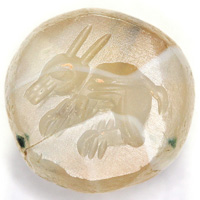 Pic. 4b
Pic. 4b
Hare
Seal Nr. 04844.3 Rat
No distinction between mouse and rat can be made. The rat is shown running. As there is not enough room to show the full length of the tail the tail is shown much shorter than in nature.
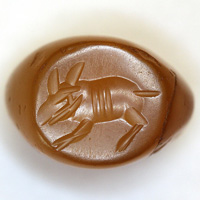 Pic. 4c
Pic. 4c
Rat
Seal Nr. 01254.4 Wolf
The distinction between wolf, dog and fox on Sasanian seals is difficult and can only be made with some arbitrariness.
The wolf is sneaking forward or is preparing to jump. It has short, pointed ears, a long tail and long talons.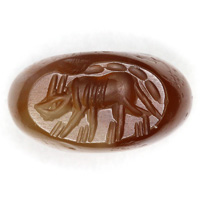 Pic. 4d
Pic. 4d
Wolf
Seal Nr. 11734.5 Fox
The fox is shown lying with its head turned back or it is hiding under a shrub. The fox has short, pointed ears and long talons. While lying the tail is not visible.
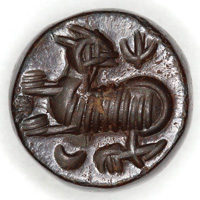 Pic. 4e
Pic. 4e
Fox
Seal Nr. 13384.6 Bear
The bear is shown walking. It has round ears, shaggy fur and long talons.
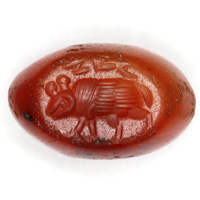 Pic. 4f
Pic. 4f
Bear
Seal Nr. 10174.7 Lion
The lion is shown lying, sitting or walking. It has a strong mane and long talons. The tail of the walking lion is clearly visible. The lying or sitting lion turns its head to the observer.
Occasionally two lions are shown or a lion with a cub. In the latter case the lion has also a mane but it can be assumed that it is a lioness.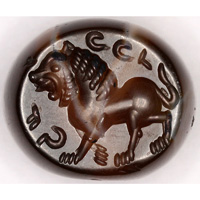 Pic. 4g
Pic. 4g
Lion
Seal Nr. 04004.8 Leopard & Tiger
We assume a feline without a mane to be a leopard or a tiger. Sometimes vertical stripes on the body make it clear that it is a tiger. The animal is walking with wide open jaws. Long talons and tail are clearly visible.
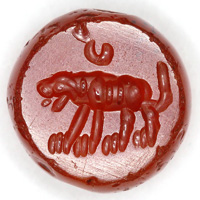 Pic. 4h
Pic. 4h
Leopard & Tiger
Seal Nr. 13374.9 Elephant
The elephant is shown walking. The small ears of the elephant in the Sigilla collection of Sasanian seals show it is an Indian elephant.
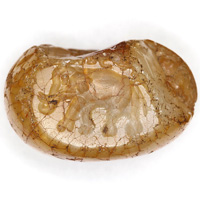 Pic. 4i
Pic. 4i
Elephant
Seal Nr. 02834.10 Horse
The horse is shown either with raised head and one raised forleg or else grazing with the head down.
There are also seals with two horses, mostly facing each other and also horse with foal.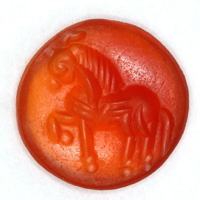 Pic. 4j
Pic. 4j
Horse
Seal Nr. 12224.11 Ass
In the Sigilla collection of Sasanian seals the head of an ass occurs only once as main motif. Sometimes the head of an ass occurs as secundary motif.
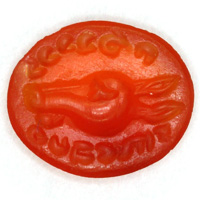 Pic. 4k
Pic. 4k
Ass
Seal Nr. 03054.12 Camel
The camel is shown walking. In the Sigilla collection of Sasanian seals there are only dromedars.
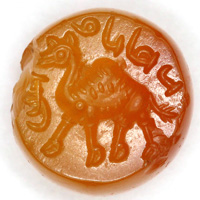 Pic. 4l
Pic. 4l
Camel
Seal Nr. 13394.13 Stag
The stags is shown with antlers. In most cases it is shown lying, but als standing. The head can be turned back, it can have a tie around the neck.
There are seals with two stags, with a stag in combination with other animals or with the head of a stag. Sometimes stags appear as prey in animal fighting scenes.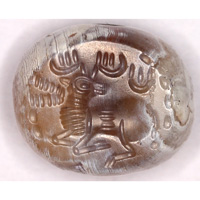 Pic. 4m
Pic. 4m
Stag
Seal Nr. 00744.14 Cattle
Cattle in most cases are shown walking, but also lying. Cattle are always of the humped type. There are seals with bulls heads. In animal fighting scenes the hump bull often appears as prey.
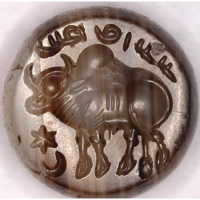 Pic. 4n
Pic. 4n
Cattle
Seal Nr. 00934.15 Ram
The ram is distinguished by its semicircular horns. It is shown walking or lying. Often it has a tie around the neck, sometimes with a pendant.
There are seals with two rams, with a ram in combination with another animal. There are seals with the head of a ram. Sometimes the ram appears in animal fighting scenes.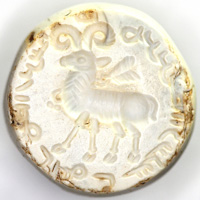 Pic. 4o
Pic. 4o
Ram
Seal Nr. 15554.16 Antelope
Antelopes are shown walking or lying. Two types of antelopes can be distinguished by their horns: oryxes have long horns slighly curved down, gazelles have shorter horns which are curved slightly upward at the ends.
There are seals with two antelopes or with an antelope in combination with other animals, sometimes with the head of an antelope only. The antelope can appear as prey in animal fighting scenes.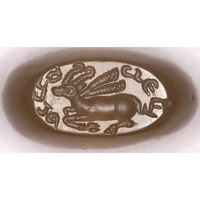 Pic. 4p
Pic. 4p
Antelope
Seal Nr. 00884.17 Bird
Seals showing several species of birds are present in the Sigilla collection of Sasanian seals. Clearly distinguishable are eagle, duck, cockerel and peacock. Differentiating between pigeon and raven is difficult.
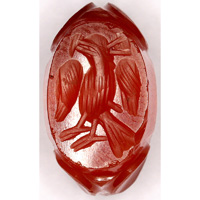 Pic. 4q
Pic. 4q
Bird
Seal Nr. 03624.18 Scorpion
The scorpion is easily recongizable by its pedipalps, its six legs and its curved tail. The tail can be curved in both directions.
The scorpion is a frequent secundary motif in addition to main motifs e.g. lion, bull, lion mask.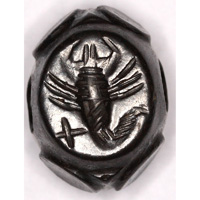 Pic. 4r
Pic. 4r
Scorpion
Seal Nr. 00404.19 Fish
It is not possible to differentiate between different species of fish on seals.
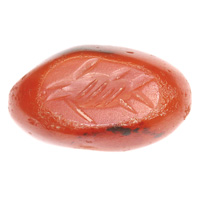 Pic. 4s
Pic. 4s
Fish
Seal Nr. 09005. Combinations of Animals
5.1 Animals Fighting, Lion Attacks
The lion attacks the standing or collapsing prey from ahead or from behind. The prey is often a hump bull, also antelopes occur.
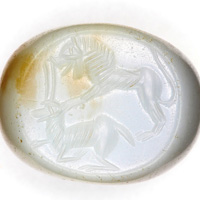 Pic. 5a
Pic. 5a
Lion Attacks
Seal Nr. 10755.2 Animals Fighting, Bird Attacks
A bird, it could be a raven or because of its curved beak an eagle or a vulture, is sitting on a lying prey. Stag, ram, antelope, bull, bulls head, bird, fish can occur. Possibly this is not a hunting scene but a scene showing a scavenger on carrion.
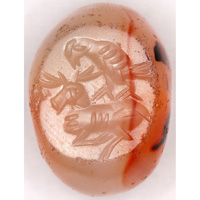 Pic. 5b
Pic. 5b
Bird Attacks
Seal Nr. 05115.3 Double Animals
There are motifs with two bodies sharing a head or two heads on a single body.
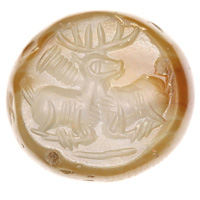 Pic. 5c
Pic. 5c
Double Animals
Seal Nr. 11475.4 Whorl
A whorl has three or more foreparts of animals rotating around a common center. This motif has a long tradition and can be traced back to the 2nd millennium BC.
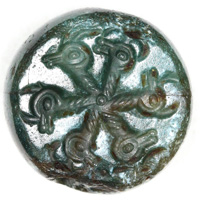 Pic. 5d
Pic. 5d
Whorl
Seal Nr. 13806. Mythical Creature
6.1 Winged Human
The winged humans in the Sigilla collection of Sasanian seals have male hairstyle. Often they are holding a diadem with ties or a plant. Legs and feet sometimes are bird-like.
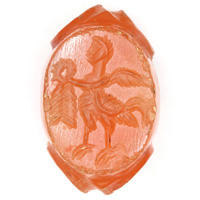 Pic. 6a
Pic. 6a
Winged Human
Seal Nr. 11526.2 Winged Horse
The winged horse is shown much like the natural horse either with head and foreleg raised or with straight or lowered head. Shown in profile most of the cases only one wing is visible, sometimes both wings. The tips of the wings are curled inward.
There are seals with two winged horses, with single or double foreparts of winged horses and with winged horses and foal.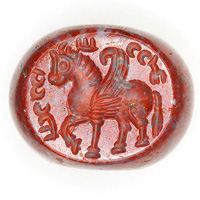 Pic. 6b
Pic. 6b
Winged Horse
Seal Nr. 13016.3 Winged Lion
The winged lion is sitting or lying and turns the head to the observer. There is no walking winged lion in the Sigilla collection of Sasanian seals.
The winged lion can also occur as forepart. There is one seal in the collection with the forepart of a winged lion together with the forpart of a winged bull.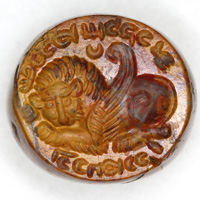 Pic. 6c
Pic. 6c
Winged Lion
Seal Nr. 15116.4 Winged Ram
There is one winged ram in the Sigilla collection of Sasanian seals. It is shown lying, both wings are visible, the tips of the wings are curled inward.
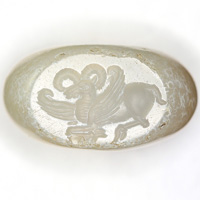 Pic. 6d
Pic. 6d
Winged Ram
Seal Nr. 11606.5 Winged Hump Bull
There are two winged hump bulls in the Sigilla collection of Sasanian seals. One seal shows the winged hump bull standing frontal, another seals shows the forepart of a winged bull together with the forpart of a winged lion.
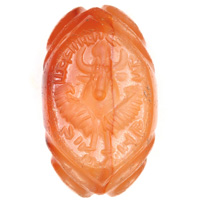 Pic. 6e
Pic. 6e
Winged Hump Bull
Seal Nr. 12916.6 Gopatšah
The Gopatšah is a creature with the body of a bull and the head of a man. It is shown lying or walking. Occasionally it is wearing a crown of feathers. Sometimes the head is oversized in relation to the body.
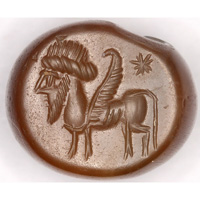 Pic. 6f
Pic. 6f
Gopatšah
Seal Nr. 04166.7 Griffin
The griffin has the body of a winged lion and the head of an eagle with pointed ears. The tail has a tassel in the middle or at the end. It is shown standing, sitting or lying. The tips of the wings are curles inward. There are also seals with single or double forparts of griffins.
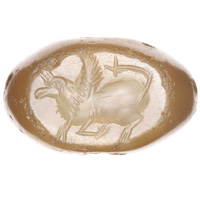 Pic. 6g
Pic. 6g
Griffin
Seal Nr. 09576.8 Gryllos
Grylloi are phantastic combinations of animals and sometimes humans. They are well known from the Greek and Roman antiquity, but also the Sasanian culture knew them.
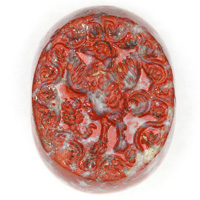 Pic. 6h
Pic. 6h
Gryllos
Seal Nr. 11506.9 Lion Mask
The lion mask is the frontal view of a lion-like head. The ears are round. It is often horned.
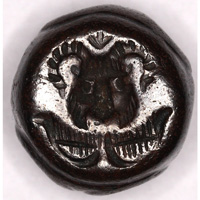 Pic. 6i
Pic. 6i
Lion Mask
Seal Nr. 01177. Plants & Natural Objects
7.1 Spray
A leafy spray on a stand.
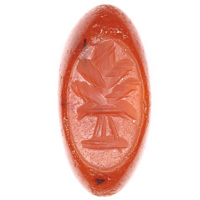 Pic. 7a
Pic. 7a
Spray
Seal Nr. 08977.2 Flower
A flower with two or four narrow petals on a stand. Publications frequently call it "tulip" but it could as well be interpreted as flower of a pomegranate. Sometimes it resembles a just blossoming bud.
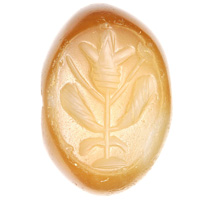 Pic. 7b
Pic. 7b
Flower
Seal Nr. 10637.3 Three Flowers
Three flowers either on a stand or tied together with a ribbon.
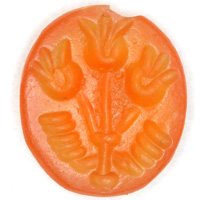 Pic. 7c
Pic. 7c
Three Flowers
Seal Nr. 10117.4 Celestial Body
Star or crescent with star.
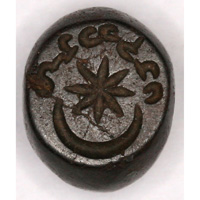 Pic. 7d
Pic. 7d
Celestial Body
Seal Nr. 03798. Object & Symbol
8.1 Altar
Some seals show a sketchy, boxlike object. For lack of a better interpretation we call it "altar". It is unknown what it is thoght to symbolize.
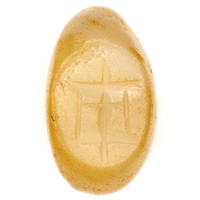 Pic. 8a
Pic. 8a
Altar
Seal Nr. 09338.2 Fire Altar
The fire altar is standing on a platform of several levels with trunk, platform and burning fire same as on Sasanian coins.
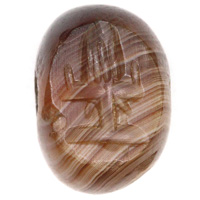 Pic. 8b
Pic. 8b
Fire Altar
Seal Nr. 10658.3 Herakles's Knot
Herakles's knot is well known from Greek and Roman antiquity. It symbolizes an inseparable union. The ends of the ropes are decorated with flowers, animal heads or ties.
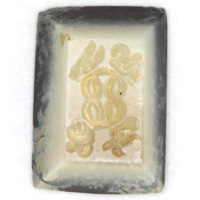 Pic. 8c
Pic. 8c
Herakles's Knot
Seal Nr. 04248.4 Star on Stand
A six pointed star, realized by thre crossing lines, is placed on a stand. Possibly this is a very sketchily made fire altar.
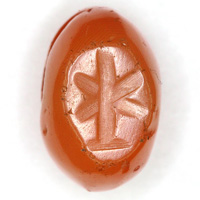 Pic. 8d
Pic. 8d
Star on Stand
Seal Nr. 13739. Tamgas
9.1 Tamga
Tamgas belong to the nomadic area and were originally used to marke the belongings of a tribe or clan. As such they are used up to this day by nomadic groups. They are comparable to the coats of arms of Europe or the kamon of Japan. Sasanian tamgas consist of several elements. Most of the time tamgas are symmetric and have a crescent as the topmost element.
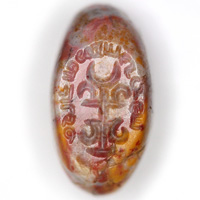 Pic. 9a
Pic. 9a
Tamga
Seal Nr. 15539.2 Monogram Tamga
A monogram Tamga looks like an ordinary tamga but is made up of letters of the Pahlevi script.
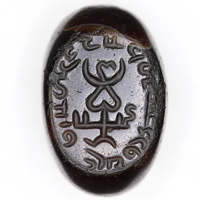 Pic. 9b
Pic. 9b
Monogram Tamga
Seal Nr. 1568 -
Time and Area of Origin
Sasanian seals are a distinct group among the seals of the Near East. They can be easily distinguished by their forms and motifs. Their time of origin is the era of the Sasanian kingdom which existed from AD 244 to AD 651 roughly in the area of present day Iran and Iraq but temporarily occupied also parts of today's Afghanistan, Tajikistan, Anatolia, the Kaukasus and Pakistan.
Collections
A large number of sasanian seals is still extant in public and private collections, R. Göbl estimates their number at several ten thousand. Many collections are already published, some of the most important are:
-
Staatliche Museen, Berlin
(about 700 items) [Horn, Steindorff, 1891) -
Eremitage, St. Petersburg
(about 800 items) [Borissov, Lukonin, 1963] -
Britisches Museum, London
(about 800 items) [Bivar 1969] -
Bibliothèque Nationale und Musée du Louvre, Paris
(together about 1000 items) [Gyselen 1993] -
Rijksmuseum van Oudheden und Koninklijk Peningkabinet, Leiden
(about 1200 items) [Gyselen 1997]
The Sigilla collection of Sasanian seals cannot match the big collections. But the publication on the internet offers the opportunity to show the items of the collection in colour photos of decent resolution and thus give a better idea of the beauty of Sasanian seals than printed publications with their black and white pictures can do.
-
Staatliche Museen, Berlin